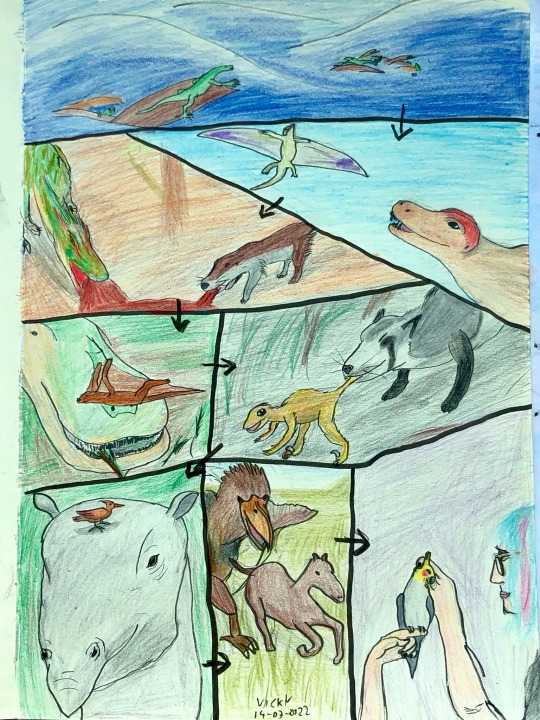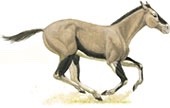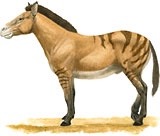#cormohipparion
Text

A long, long time ago, back in the Carboniferous, one species of little amniotes was split in two. As their paths diverged, one group’s descendants became the sauropsids - such as reptiles, birds, and other dinosaurs - and the other group’s descendants became the synapsids - such as therapsids, cynodonts, and mammals. As the millions of years stretched on, our two clades have shared the same planet and lived alongside each other as each evolved into ever new and fascinating forms.
(in every panel, there’s a sauropsid on the left and a synapsid on the right)
-In the Permian, a Titanophoneus looks up in wonder as a Weigeltisaurus glides overhead.
-In the Triassic, a Coelophysis and a Kataigidodon cautiously share a bite of a large piece of carrion they both found.
-In the Jurassic, a Maiopatagium glides around a feeding Mamenchisaurus, hunting the insects attracted by the huge sauropod.
-In the Cretaceous, a Didelphodon captures a young Bambiraptor.
-In the Paleogene, a Picavus rests for a moment on the head of a Paraceratherium.
-In the Neogene, a Titanis hunts a Cormohipparion.
-In the Quaternary, a human gives her pet cockatiel scritches.
#synapsid#sauropsid#reptile#dinosaur#bird#evolution#amniote#titanophoneus#weigeltisaurus#coelophysis#kataigidodon#maiopatagium#mamenchisaurus#didelphodon#bambiraptor#picavus#paraceratherium#titanis#terror bird#cormohipparion#human#cockatiel#i based the coelophysis and didelphodon coloration on walking with dinosaurs#but gave the coelophysis feathers#also as you can see i drew titanis way too fat at first and had inked it before i noticed my mistake#human is based mostly on myself#though i do not have a cockatiel#(yet?)#paleoart#my art
63 notes
·
View notes
Text





Fossil horses from the Ashfall Fossil Beds in Nebraska, a site whise richness of mammal fossils is attributed to a large Yellowstone eruption. Horse remains are plentiful, with five genera known to be present. They are depicted above in the following order: Pseudohipparion, Neohipparion, Cormohipparion, Protohippus, and Pliohippus. The first three genera are three-toed, while the last two bear single hooves.
Source
#horse#evolution#extinct#ashfall#fossil beds#nebraska#yellowstone#pseudohipparion#neohipparion#cormohipparion#protohippus#pliohippus#miocene
3 notes
·
View notes